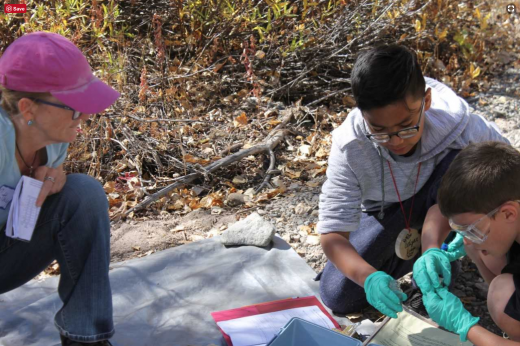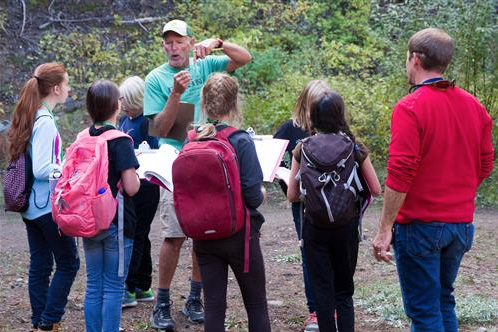Photo courtesy of Blaine County School District
By Cathy Tyson
Earlier this fall, I became a field scientist, chemist and sixth-grade teacher. Mostly, my work for TU is behind a desk, crunching numbers. But each September, I feel like Clark Kent taking off his tie, and putting on a cape, as I get back to my environmental education roots.
Each year, I have the privilege of spending four days as a volunteer instructor at the environmental camp provided to Wood River Middle School sixth graders. Trout Unlimited supports this educational opportunity, allowing me to join a team of teachers and volunteers leading about 200 sixth graders through a scientific investigation using the scientific method. My investigation: “What is the health of the Big Wood River?”
This somewhat general question is posed to kids seated beside the Big Wood River where they jump into the scientific method with a hypothesis about the river’s health. They start by using their eyes, ears, noses and prior learning. Then we pull out the chemistry experiment kits, and it’s time for some nerdy fun (this was initially daunting for me, as someone who was scared to touch test tubes in high school and college – afraid I’d cause an unintended explosion). But, at the camp, I confidently explained that reagents are substances used in chemical analysis, and we were confident they would not cause unexpected explosions. Then kids gathered river water samples and put it through some of the test used nationally to determine water quality: pH, phosphate, nitrate, dissolved oxygen and temperature.

Photo by Cathy Tyson
Donned in surgical gloves and eye protection, kids poured reagents into test tubes to conduct experiments only feet from the river. For some experiments, they used color comparators to determine chemical concentrations for parameters including pH, total dissolved oxygen, phosphates and nitrates. Finally, data was aggregated, and results were tabulated, compared and discussed.
So what did the kids find? What was the health of the Big Wood River at the base of the Boulder Mountains north of Ketchum that golden September week?
Test results usually identified the water quality as “good.” However, some results were worse, indicating “medium” water quality, which most of us considered unlikely based on our pristine surroundings. We then discussed the validity of our testing, as well as means for verifying the accuracy of results, and for testing water quality (incorrect math calculations were often the culprit for our skewed results). I have found that science is about asking questions and looking for answers. And that often leads to asking more questions — cyclical, like the natural world.
Once the chemistry kits were stored, and all the paperwork completed, I was rewarded with questions and ideas about the river, its fish, and how we affect those, both positively and negatively. To my delight, most of the kids smile and nod when I ask if they might consider careers in science.
Some people only get to go to camp once. I am fortunate enough to get to go every year. It transforms me from a mild-mannered administrator to a powerful, environmental educator. I get to help kids connect with their environment, don a scientist’s perspective, and perform chemistry experiments fearlessly.
This is my favorite week at work.
Cathy Tyson is the office administrator for the Idaho Water Project in Hailey, Idaho.



